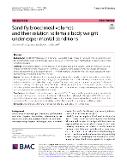Sand fly blood meal volumes and their relation to female body weight under experimental conditions

Publication date
2024Published in
Parasites & VectorsVolume / Issue
17 (1)ISBN / ISSN
ISSN: 1756-3305ISBN / ISSN
eISSN: 1756-3305Metadata
Show full item recordCollections
This publication has a published version with DOI 10.1186/s13071-024-06418-y
Abstract
Background Sand fly females require a blood meal to develop eggs. The size of the blood meal is crucial for fecundity and affects the dose of pathogens acquired by females when feeding on infected hosts or during experimental membrane-feeding. Methods Under standard laboratory conditions, we compared blood meal volumes taken by females of ten sand fly species from four genera: Phlebotomus, Lutzomyia, Migonomyia, and Sergentomyia. The amount of ingested blood was determined using a haemoglobin assay. Additionally, we weighed unfed sand flies to calculate the ratio between body weight and blood meal weight. Results The mean blood meal volume ingested by sand fly females ranged from 0.47 to 1.01 mu l. Five species, Phlebotomus papatasi, P. duboscqi, Lutzomyia longipalpis, Sergentomyia minuta, and S. schwetzi, consumed about double the blood meal size compared to Migonomyia migonei. The mean body weight of females ranged from 0.183 mg in S. minuta to 0.369 mg in P. duboscqi. In males, the mean body weight ranged from 0.106 mg in M. migonei to 0.242 mg in P. duboscqi. Males were always lighter than females, with the male-to-female weight ratio ranging from 75% (in Phlebotomus argentipes) to 52% (in Phlebotomus tobbi). Conclusions Females of most species took a blood meal 2.25-3.05 times their body weight. Notably, the relatively tiny females of P. argentipes consumed blood meals 3.34 times their body weight. The highest (Mbl/Mf) ratios were found in both Sergentomyia species studied; females of S. minuta and S. schwetzi took blood meals 4.5-5 times their body weight. This parameter is substantially higher than that reported for mosquitoes and biting midges.
Keywords
Phlebotomus, Lutzomyia, Sergentomyia, Blood meal, Prediuresis, Haemoglobin
Permanent link
https://hdl.handle.net/20.500.14178/2598License
Full text of this result is licensed under: Creative Commons Uveďte původ 4.0 International







